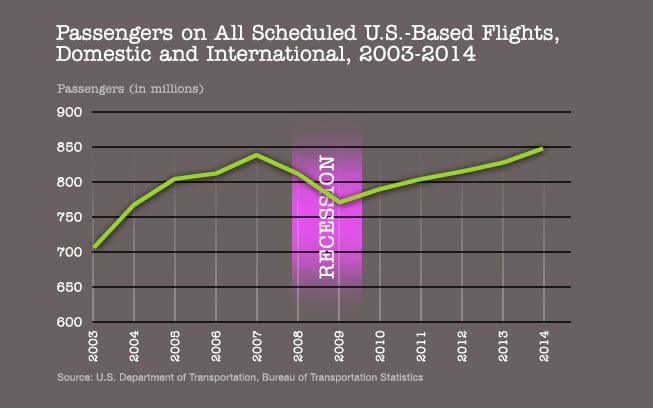Passenger levels on commercial airlines reached an all-time high in the United States in 2014 with 848.1 million passengers served, according to the U.S. Department of Transportation’s Bureau of Transportation Statistics.
The 2014 figure represents growth of 2.5 percent over 2013, and is 1.2 percent higher than the previous peak year of 2007.
Domestic travel grew at a slightly more brisk pace than international travel in 2014. BTS reported a 2.6 percent rise in the number of passengers on domestic flights, to 662.3 million passengers. The number of passengers on international flights operated by U.S. and foreign airlines increased 2.3 percent to 185.8 million.
Average load factors declined slightly in 2014 as carriers bumped up capacity, particularly on international flights. The average load factor fell to 82.7 from 82.8 in 2013, which was the highest annual systemwide load factor on record.
Hartsfield-Jackson Atlanta International (ATL) once again topped the list of airports ranked by passenger numbers, with 46.57 million enplaned passengers in 2014, a 2.9 percent increase. ATL was followed by Los Angeles International (LAX) at 33.94 million enplanements and Chicago O’Hare International (ORD) at 33.45 million enplanements.
The top 10 airports ranked by enplanements all registered passenger gains in 2014.
John F. Kennedy International (JFK) had the highest number of international scheduled enplanements in 2013 at 13.46 million, a 2.9 percent decline. Miami International (MIA) ranked second despite a 1.6 percent drop to 9.67 million international enplanements.
Among carriers, Delta Air Lines carried more total system passengers in 2014 than any other U.S. airline for the fifth consecutive year. United Airlines carried more passengers on international flights to and from the U.S. in 2014 than any other U.S. or foreign carrier for the third consecutive year. British Airways carried the most passengers on flights to and from the U.S. of any foreign airline.






